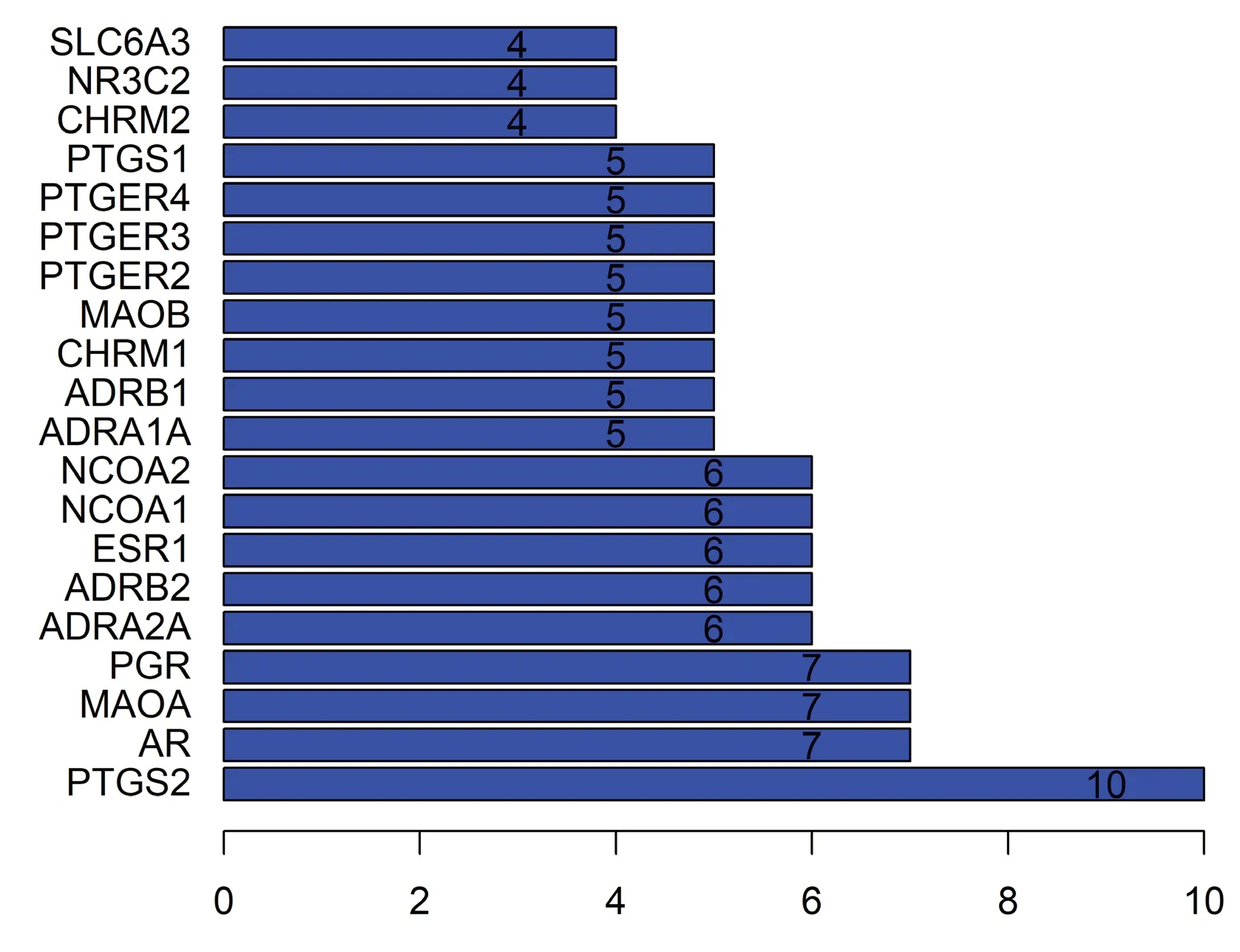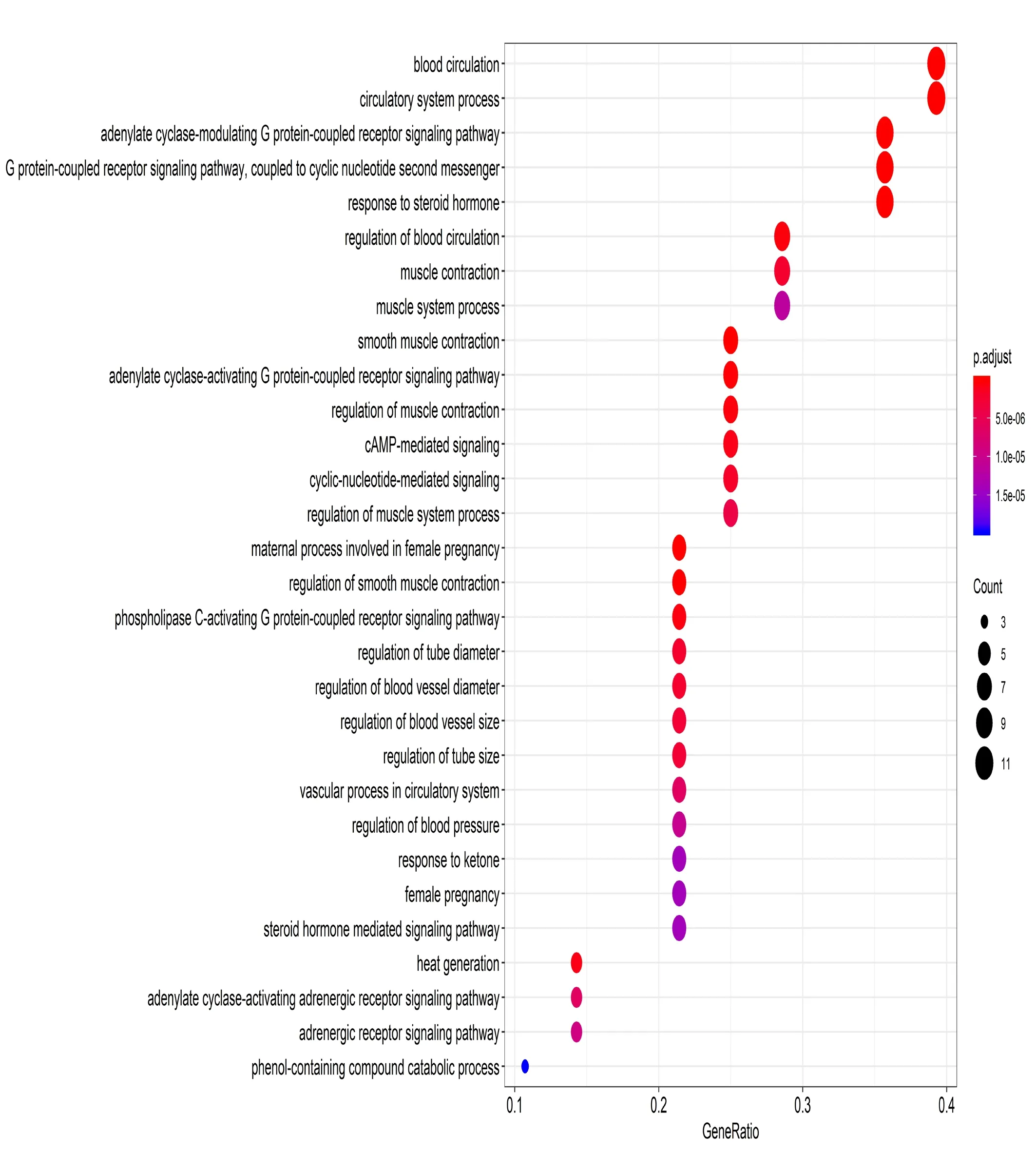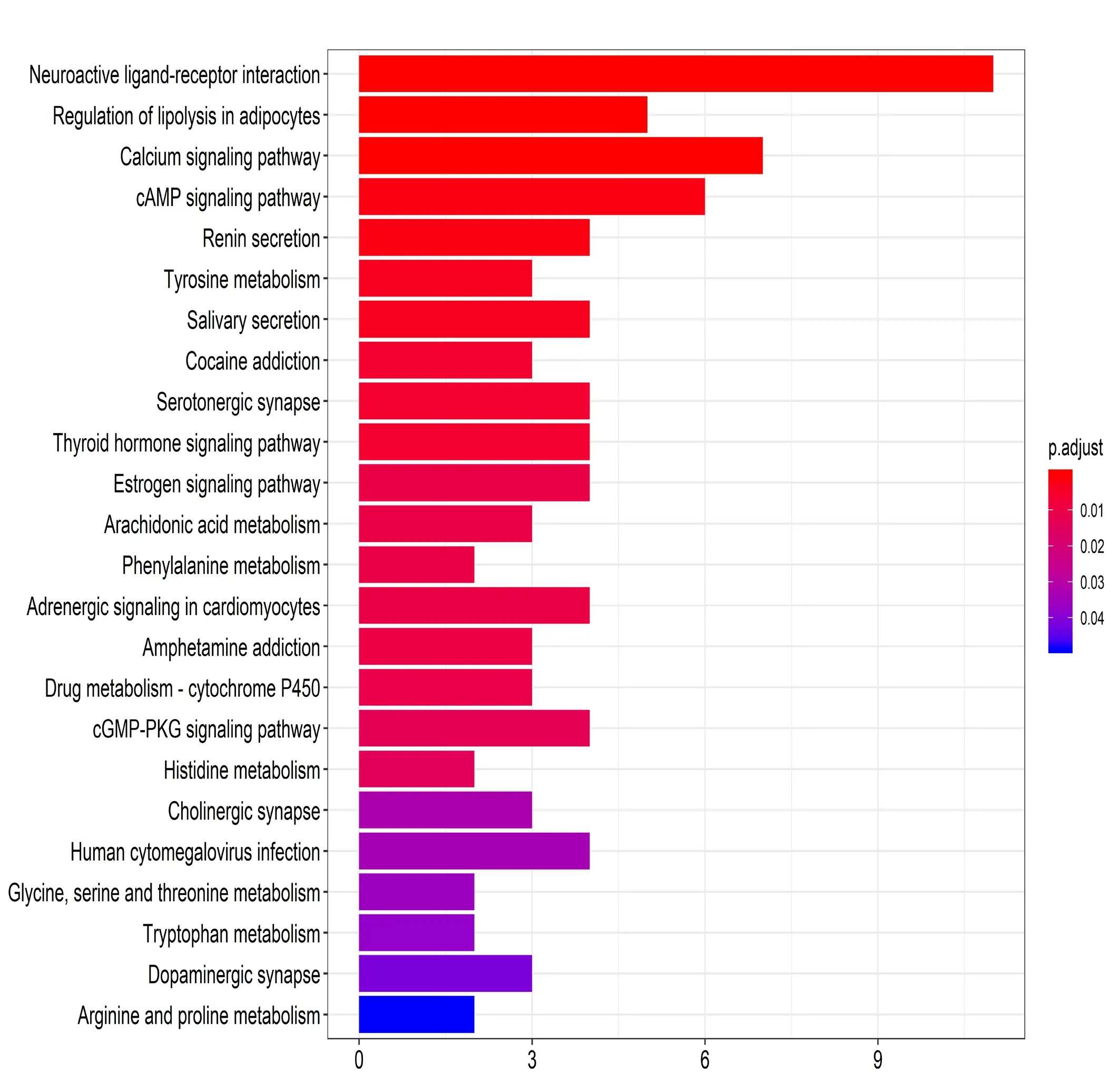Study on the mechanism of Coix seed in the treatment of colon cancer Based on network pharmacology
Jin-Lin Wu,Zhu Yang,,Feng-Xi Long,,Li Luo,3,Xun Liu,Jia Wang,Ting Yu,Dong-Xin Tang,*
1Graduate School,Guizhou University of Traditional Chinese Medicine,Guiyang 550002,China;
2Department of Traditional Chinese Medicine,Guizhou Provincial TCM Inheritance and Technology Innovation Talent Base,Guiyang 550002,China;
3Oncology Department,Guihang Group 300 Hospital,Guiyang 550000,China.
Abstract Objective:Study on the mechanism of Coix seed in the treatment of colon cancer based on network pharmacology.Methods:The main chemical components of Coix seed were identified by TCMP,and the target sites of drug components were screened.The target of the protein was mapped to the corresponding gene target through the Uniprot database.Genecards database was used to find the target gene of human colon cancer disease,and then the disease gene target was combined with the drug gene target to screen the common target of disease-drug composition,and the STRING platform was used to construct the drug component-disease target protein interaction.(PPI)network model.The Bioconductor database was used to analyze the potential targets,related molecular functions and signaling pathways of cocoon in the treatment of colon cancer by GO and KEGG enrichment.The disease-drug component-target-signal pathway network was established by Cytoscape software.Results:It was found that there are 9 pharmacodynamics and 28 targets related to colon cancer treatment,and GO functional enrichment analysis is based on correction.P<0.05 screened 346 molecular functional related items,including 256 biological processes,48 molecular functions,and 42 cell components.KEGG functional enrichment analysis screened 24 related pathways according to the adjusted P<0.05.Conclusion:PTGS2,AR,ESR1,PGR,ADH1C,AKR1B1,LTA4H,NCOA1,NCOA2 and other related targets may be potential targets for the treatment of colon cancer.
Key words:Coix seed,Colon cancer,Network pharmacology,Mechanism
Introduction
Colon cancer is a malignant lesion of colon mucosal epithelium caused by many carcinogenic factors,such as environment or heredity.As a common malignant tumour of digestive tract,the incidence of colon cancer has shown an increasing trend in recent years.According to the global report on the incidence and mortality of malignant tumors in 2018 [1],there are about 1 million new cases of colon cancer and more than 550,000 deaths,ranking fourth in the global malignant tumors.In the treatment of colon cancer,surgery is the main method,combined with chemotherapy and targeted therapy.But at present,the treatment of cancer advocates the principle of individualized comprehensive treatment.Traditional Chinese medicine plays an increasingly important role in the treatment of colon cancer.The application of Chinese herbal medicine and proprietary medicine may become a new choice for the treatment of intestinal tumors in the future,especially for accelerating the recovery of body function after operation.
Coix seed,also known as Coix rice and coix bead,is derived from the mature seeds of Coix seed,which is a grass herbal plant.It has great potential for medicinal use.Coix seed is cool,slightly cold and tasty.It belongs to the lung,spleen,stomach and large intestine meridians.It has the functions of invigorating the spleen and stomach,diuresis,relieving diarrhea,relaxing tendons and removing obstruction,clearing heat and removing abscess.Modern medical research found that coix seed contains a variety of active ingredients,including esters,unsaturated fatty acids,carbohydrates and lactams [2].It has the functions of anti-cancer,improving immunity and lowering blood sugar.It is widely used in the treatment of malignant tumors such as lung cancer,intestinal cancer,gastric cancer,liver cancer and cervical cancer.At present,coix seed preparations such as coix seed oil and KLT have been used in patients with colon cancer and achieved good clinical efficacy [3-4].Professor Liu Shangyi,a great doctor of traditional Chinese medicine,has developed Chanling Gao on the basis of Gegen Powder.Coix seed is the main medicine,which has the effects of Tonifying Qi and nourishing yin,removing blood stasis and dispersing knots.It has a remarkable curative effect in the treatment of colon cancer and other cancers [5-7].However,due to the characteristics of Chinese herbal medicine such as multi-component,multi-target and synergistic action,how to determine the effective components of Coix seed in the treatment of colon cancer,further analyze the potential targets of the effective components,and the correlation between the targets and colon cancer,to clarify the mechanism of Coix seed in the treatment of colon cancer,we chose the formula of network pharmacology.Law to elaborate and explain.
Network pharmacology is a discipline that studies the evolution of disease from the perspective of biological networks,understands the interaction between drugs and the body,and guides the development of new drugs.It can use high-throughput omics data,molecular network data and computer simulation analysis to study the mechanism of drug action and drug innovation.It is especially suitable for drugs with complex chemical composition,multiple action targets and incomplete pharmacological and pharmacodynamic analysis.This study intends to analyze the target,mechanism and possible signal transduction pathway of Coix seed in the treatment of colon cancer through network pharmacology,reasonably predict and scientifically infer the molecular mechanism of Coix seed in the treatment of colon cancer,and provide a more powerful basis for the clinical application of Coix seed and its pharmaceutical preparations.
Materials and methods
Application of relevant databases and software
TCMSP database (TCMSP:Pharmacological technology platform of TCM system http://lsp.nwu.edu.cn/),BATMAN database (http://bionet.ncpsb.org/batman-tcm./),Uniprot database (https://www.uniprot.org/),STRING database(https://string-db.org/),Genecards database (https://www.genecards.org/),Perl software(http://www.perl.org/),Bioconductor database (https://www.bioconductor.org/),UltraEdit software text editor,Java 8.0 software,Cytoscape 3.7.1 software and R language software (https://www.r-project.org/).
Screening of Pharmaceutical Chemical ingredients
TCMSP database was used to input the Chinese name of Coix seed and click on the corresponding Latin name(Coicis Semen).According to the principle of ADME/T(absorption,distribution,metabolism,excretion and toxicity of compound to organism)of traditional Chinese medicine,Oral bioavailability (OB)and drug-like (DL)were used as screening indicators for coix seed compounds.All compound components with OB>30% and DL>0.18 were used as alternative active ingredients [8];another BATMAN database would be used.Coix seed is supplemented with effective chemical ingredients.
Chemical active ingredients target prediction
The TCMSP database and the BATMAN database were used to predict the effective chemical ingredients of Coix seed.The full English name of the corresponding potential targets selected by the screening are associated with the uniprot.tsv file edited from the Uniprot database by perl software,and the target genes name corresponding to the potential targets are found by mapping [9].
Colon cancer gene targets prediction
According to the GeneCards database,the colon cancer English name colon cancer was searched to obtain the gene targets related to colon cancer.Due to the large number of targets,the gene targets with a correlation score of≥1 were selected as candidate gene targets.
Drug-related gene targets and disease gene targets docking
The collected drug-related gene targets and disease gene targets are edited by R language software to find the intersection of the targets shared by the two,and the intersection is the drug-disease-related gene target.
Network construction and enrichment analysis
By predicting the effective chemical composition and target of Coix seed,the relationship between the target and ingredient-target of colon cancer was obtained.Cytoscape 3.7.1 software was generated on the basis of Java 8.0 software,and the drug-ingredient-target-disease network diagram was constructed.In addition,the PPI network of potential targets is constructed through STRING database.Using Bioconductor database and R language software programming,GO and KEGG enrichment analysis was carried out to predict the molecular activities and related signaling pathways of Coix seed in the treatment of colon cancer.
Results
Screening results of chemical constituents from coix seed
In TCMSP database,nine candidate chemical constituents were screened with OB > 30% and DL > 0.18 as screening indexes,including common chemical constituents of Coix seed such as Sitosterol alpha 1,Mandenol,Coixenolide and so on.The specific chemical constituents were coded and screened out in Table 1.
Protein target prediction of chemical active ingredients
Protein target prediction of the nine effective chemical ingredients of Coix seed was carried out.Among them,TCMSP database can be used to collect Y1-2,Y5-9 chemical active ingredients corresponding targets,lacking Y3,4 chemical ingredients corresponding protein targets.The screened protein targets were correlated with the uniprot.TSV file by Perl software.A total of 48 pairs of chemical ingredient-action target pairs were obtained by mapping,as shown in Table 2.

Table 1 Selected chemical ingredients of Coix seed
Colon cancer target gene prediction results
The GeneCards database was used to search for colon cancer-related gene targets,and a total of 9636 gene targets with a correlation score of ≥1 were selected as candidate genes.
Drug-related gene targets and disease gene target docking results
The collected drug-related gene targets and disease gene targets are searched for the common target by R language software,and the drug-disease-related gene targets are intersected,and the drug-related targets are screened for 31 genes.There are 28 genes in the intersection with the disease genes,as shown in Figure 1.
As the time drew near she divided all her little possessions between her sisters, and said good-by to everything she loved, and when the fatal day came she encouraged and cheered her father as they mounted together the horse which had brought him back

Figure 1 Drug-Disease-Related gene targets Venn diagram
Protein Interaction PPI Network Construction Results
Using the STRING database to construct a potential target-relationship PPI network,a total of 28 potential targets,analysis of PPI findings:one of the targets SCN5A did not see a connection relationship,obtained 27 different levels of interaction relationship targets;and through R language software.After programming,there are 126 edges,and the number of connections between a single target and the surrounding target is programmed by R language software:PTGS2,AR,MAOA,PGR,ADRA2A,ADRB2,ESR1,NCOA1,NCOA2,ADRA1A,ADRB1,CHRM1,MAOB,PTGER2,PTGER3,PTGER4,PTGS1,CHRM2,NR3C2,SLC6A3,PLAU,ADH1C,CHRM3,LTA4H,RXRA,AKR1B1 and GABRA1.Among them,the PTGS2 gene target is the core potential target with the largest number of connected lines,and the number of surrounding targets is 10,and the top 20 of the number of connected lines are represented by a histogram.The details are shown in Figure 2A and 2B below.

Table 2 Chemical Ingredient-Target Correspondence Table
Enrichment analysis results
The Bioconductor database combined with R language software was used to predict the GO function enrichment analysis and KEGG signal pathway enrichment analysis for 28 related targets for the treatment of colon cancer.
GO function enrichment analysis results: According to the calibration P<0.05,346 molecular functional related items were screened,including 256 biological processes.Including cardiovascular regulation,muscle contraction,response to steroids,adenylate cyclase-activated adrenergic receptor signaling pathway,G-protein coupled acetylcholine receptor signaling pathway,response to acetylcholine,dopamine metabolic process neurotransmitters Metabolic processes,amino acid activity and metabolism etc.48 molecular functions,including G protein coupled receptor activity,adrenergic receptor activity,phospholipase and peroxidase and other enzyme activities,steroid binding,neurotransmitter receptor activity,hormone receptors and nuclear receptors Activity,etc.42 Cell compositions,Including post-synaptic membrane formation,cholinergic and dopaminergic synapses,organelle outer membrane,GABA complex formation,etc.The first 30 entries are listed in the figure.The size and color of the nodes in the bubble diagram are determined by the number of functional enrichment related genes and the corrected P value.The corrected P value of color from red to blue reaction is from small to large,and the number of node from small to large reaction related genes is from small to large.
KEGG pathway enrichment analysis results:24 related pathways were screened according to the correctedP<0.05.These include neuroactive ligand-receptor interactions,dopaminergic,serotoninergic and cholinergic synapses,arachidonic acid metabolism,adrenergic signaling in cardiomyocytes,phenylalanine,tyrosine,Histidine,tryptophan,arginine,proline,glycine,serine and threonine metabolism,Drug metabolism-cytochrome P450,calcium signaling pathway,cGMP-PKG signaling pathway,cAMP signaling pathway,thyroid hormone signaling pathway,estrogen signaling pathway,etc.The length and color of columnar columns are determined by the number and P value of pathway enrichment related genes,the P value of color reaction from red to blue ranges from small to large,and the number of columnar response related genes from short to long ranges from small to large (Figure 4).

Figure 2A Drug-Disease associated target interaction diagram

Figure 2B Potential target-target association number histogram
Disease-Drug ingredient-target-signal pathway network construction
The obtained diseases,drugs,ingredients,targets and signaling pathways are made into network.txt and type.txt and imported into Cytoscape 3.7.1 software respectively.The attributes of source nodes,radiation nodes and edges are set up,and the network diagram of disease-drug ingredients-targets-signaling pathways is constructed.The resulting network diagram is shown in Figure 5.There are 61 nodes,172 edges,1 node for coix seed and colon cancer,7 nodes for effective chemical composition,28 potential targets and 24 nodes for signal pathway.The average number of neighbors in the network is 5.639.

Figure 3 Bubble Diagram of GO Functional Enrichment Analysis

Figure 4 KEGG signal pathway enrichment analysis histogram

Figure 5 Disease-Drug ingredient-Target-Signaling Pathway Network
Discussion
According to the above prediction and analysis,there are 9 effective ingredients in Coix seed,among which 7 ingredients correspond to 31 potential targets,which intersect with genes related to colon cancer,and 28 drug-disease-related targets are obtained.GO function enrichment analysis and KEGG pathway enrichment analysis are carried out on the intersecting targets,and molecular processes,biological functions and functions are obtained.There are 346 items related to cell composition,including 256 biological processes,48 molecular functions and 42 cell components.24 signal pathways related to disease indicate that coix seed is the result of multi-component,multi-target,multi-function and multi-channel interaction in the treatment of colon cancer.
The above analysis showed that Coixenolide and sitosterol were significantly correlated with anti-tumor effects.Liu Xing et al.analyzed the main anti-tumor components of coix seed oil,including coix seed,by gas chromatography(GC),gas chromatography-mass spectrometry (GC-MS),and high performance liquid chromatography (HPLC).And other unsaturated fatty acids,as well as sterols [10].In 1961,Japanese scholar Ukita Chunoshin first isolated the anti-tumor effect of coix seed ester from Coix seed.Its anti-tumor mechanism mainly includes inhibiting tumor neovascularization,promoting apoptosis and inhibiting tumor cell proliferation [11].Bao Xueming et al.[12]observed the effects of coixenolide on proliferation and apoptosis of human colon cancer cell line SW480 by in vitro experiments.SW480 cells were divided into control group and high-,medium-,and low-dose group (20mg/L,10mg/L,5mg/L).The cells were detected by thiazolyl blue colorimetry and flow cytometry.The growth and detection of cell cycle and apoptosis were observed.The results showed that coixyl ester can directly inhibit the proliferation of colon cancer cells and induce apoptosis in vitro.Jiang Xiaoling et al.[13]used the serum-free culture model of thoracic and abdominal aortic rings to detect the effect of coixenol ester on angiogenesis.The experimental results showed that coixenol ester had a significant inhibitory effect on angiogenesis of tumors.It was considered that inhibiting angiogenesis was one of the main ways of coixenol ester against tumors.Sitosterol is a natural sterol molecule in Coix seed.Its anti-tumor effect can be achieved by interfering with a variety of cell signaling pathways,including cell cycle,apoptosis,proliferation,survival,invasion,angiogenesis and inflammation.It has anti-cancer properties including colon cancer and other tumors [14].Sitosterol has antioxidant function and can be used as an effective drug to reduce oxidative stress induced by 1,2-dimethylhydrazine (DMH)in Wistar rats,and as an effective chemical to prevent colon cancer [15].Kou Mingyu et al found through animal experiments that sterol can inhibit colorectal cancer induced by chemical carcinogens.Its mechanism may be related to inhibiting bile acid inflow into the large intestine and reducing cancer cell proliferation [16].
Among the potential targets of drug-disease,there are PTGS2,AR,ESR1,PGR,ADH1C,AKR1B1,LTA4H,NCOA1,NCOA2 and other targets that are highly correlated with the development of colon cancer.Kosumi K et al.[17]found that the correlation between PTGS2 expression and colon cancer mortality was stronger in BRAF mutant tumors than in BRAF-wild type tumors,supporting the prognostic interaction of PTGS2 expression and BRAF mutation status.Huang R et al [18]proposed that the somatic changes of CAG repeat in AR gene are related to colon cancer.Studies have shown that the loss of long CAG repeat gene sequence and AR expression is closely related to the development of colorectal cancer.Both long CAG and AR expression reduction were associated with 5-year OS differences in colorectal cancer patients.ESR1 and PGR as tumor suppressor genes can inhibit the progression and metastasis of colon cancer.Lin JH et al.[19]found that ESR1 and PGR-related gene mutations can increase the risk of colon cancer in women through observational studies and randomized trials.An alcohol-colon cancer-related cohort study showed that alcohol-colon cancer association may vary depending on gender and ADH1B and ADH1C genotypes [20].Among male drinkers,ADH1B increases the risk of distal colon cancer.Among female drinkers,ADH1C increases the risk of proximal colon cancer.A member of the AKR1B1 oxidoreductase family,which is involved in the pathophysiology of diabetes and cancer,including the development of colon cancer,and the high expression profile of AKR1B1 indicates that colon cancer patients can have a better prognosis [21].Leukotriene A4 hydrolase (LTA4H)is a pro-inflammatory enzyme that produces inflammatory mediator leukotrienes,which may play an important role in chronic inflammation-related carcinogenesis and is a highly expressed enzyme in colorectal cancer [22].Meerson A et al.[23]found that miR-4443 inhibits tumors by down-regulating MEK-C/EBP-mediated leptin and insulin signaling downstream of TRAF4 and NCOA1 and insulin and/or leptin resistance (eg obesity)Modes play a role in inhibiting this pathway and increasing the risk of metastatic colon cancer,indicating that NCOA1 is highly correlated with colon cancer metastasis.Yu J et al found that through gene sequencing and experiments,NCOA2 is a new negative growth regulator gene,inhibiting Wnt/beta-catenin pathway in colon cancer cells,and ultimately inhibiting the development and metastasis of colon cancer [24].
In signaling pathways,including amino acid metabolism of phenylalanine,tyrosine,histidine,tryptophan,arginine,proline,glycine,serine and threonine,calcium signaling pathway,cGMP-PKG signaling pathway,cAMP signaling pathway,thyroid hormone signaling pathway,estrogen signaling pathway are all involved in the development of colon cancer.Exhibition,invasion and metastasis.Santhanam S et al.[25]studied tryptophan metabolism as a risk factor for CRC,which involved host mucosal immune system,key transcriptional pathways of tumor growth and intraluminal microorganisms,and emphasized the current available small molecule inhibitor tryptophan-related targeted therapy for colon cancer.Yu H et al.[26]studied the effects of cGMP-PKG signaling pathway and calcium signaling pathway on cell cycle and DNA replication of colon cancer cells.It was found that a group of independent CRC patients validated the validity of specific DNA methylation regulatory gene module in colon cancer.Results Differential gene expression analysis showed that cGMP-PKG signaling pathway and calcium signaling pathway were involved.CRC cell cycle and DNA replication were up-regulated,which negatively regulated the growth of tumors.Tsai et al.[27]can stimulate the growth and proliferation of HCT116 colon cancer cells by activating cAMP/CREB signaling pathway,which can be verified by WB and ELISA.Secondly,cAMP signaling pathway can stimulate protein tyrosine phosphatase and reduce Erk1/2 activity through a new way,and down-regulate the fluorescence of HT-29 colon cancer cells.The expression of dipeptidyl polypeptidase IV (DPPIV)in enzyme assay [28].Drug metabolism-cytochrome P450 is mainly related to drug resistance of colon cancer drug 5-Fu [29].
Although the integrity and systematicness of network pharmacology are compatible with the concept of traditional Chinese medicine and its multi-component,multi-target,multi-function and multi-channel,and can provide more theoretical basis for the rational promotion of traditional Chinese medicine through large data mining,there are still some shortcomings to be solved in this study.For example,further enlargement of active ingredients of drugs,increase of potential targets related to diseases,and understanding of biological processes and related pathways of drug action and cancer diseases require further sequencing and experimental verification of tumour genes.
- Food and Health的其它文章
- Potential relevance of diet to breast cancer
- The problems of nutritional support for head and neck malignant tumor patients undergoing radiotherapy
- The therapeutic mechanism of black soybean in atherosclerosis based on network pharmacology
- Nutritional support strategies for cancer cachexia

